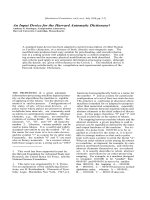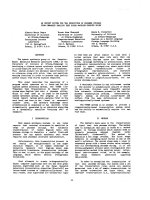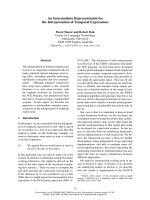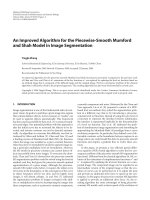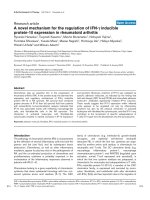Báo cáo y học: "An alternate solution for the treatment of ascending aortic aneurysms: the wrapping technique" pps
Bạn đang xem bản rút gọn của tài liệu. Xem và tải ngay bản đầy đủ của tài liệu tại đây (366.03 KB, 2 trang )
LET T E R S TO THE EDITOR Open Access
An alternate solution for the treatment of
ascending aortic aneurysms: the wrapping
technique
Georgios I Tagarakis
1*
, Dimos Karangelis
1
, Andony J Baddour
1
, Marios E Daskalopoulos
1
, Vassilios T Liouras
1
,
Dimitrios Papadopoulos
2
, Konstantinos Stamoulis
2
, Stefania S Lampoura
1
, Nikolaos B Tsilimingas
1
Abstract
Background: The aortic Dacron wrapping technique is a surgical technique used under certain circumstances in
cases of ascending aorta dilatation. Herein, we are presenting our experience on the method performed on
multimorbid patients who denied major aortic surgery.
Methods: We included in our series 7 patients (5 male-2 female) with mild to moderate ascending aortic
dilatation, who were operated with the wrapping technique. One patient was submitted to biological aortic valve
replacement during the same procedure. The number of conventionally operated patients during the same period
(2 years) was 21.
Results: Mortality during the 18-months follow-up control was 0%. One patient had to be operated with biological
aortic valve replacement 18 months after the initial wrapping operation, although the diameter of her ascending
aorta remained stable.
Conclusions: The Dacron wrapping technique is a me thod that can alternatively be used in multimorbid patients
with mild to moderate ascending aortic dilatation without dissecting elements and has generally good results.
Letter to the Editor
Dear Editor
Even in the current time of advanced surgical proce-
dures and endovascular alternative techniques f or the
treatment of aortic pathologies, ascending aortic aneur-
ysms remain a challenging problem for every cardiac
surgeon. This is why our utmost interest was focused
on the arti cle recently published in your esteemed jour-
nal by Ang et al [1]; it dealt with the interesting topic of
ascending aortic wrapping in cases of mild to moderate
ascending aorta dilata tion during aortic valve replace-
ment procedures. Herein, we would like to present our
own experience with the wrapping technique, which we
used as an alternative procedure in the two-year period
2007 and 2008 in a series of 7 multimorbid patients
who were at risk for major surgery, which they definitely
refused. During the same period, the number of patients
with ascending aortic aneurysm who were submitted to
conventional ascending aortic aneurysm operation in
our department was 21. The wrapping technique was
not necessa rily combined with aortic valve repair/repla-
cement, and the morbid conditions of our patients
included combinations of advanced age and severe
organic or metabolic insufficiencies, such as diabetes
mellitus, hypothyreoidism, coronary artery disease, pre-
vious CABG, severe heart or renal failure, chronic
obstructive pulmonary disease and adipositas p er
magna. These patients, whose characteristics can be
seen in table 1, concentrated c lassical indications f or
ascending aorta replacement, but, due to the increased
surg ical risk and their wish to avoid major surgery, they
were submitted to the Dacron wrapping technique, with
excellent results in the long-term(18months)follow-
up control.
Intra-and perioperative mortality was 0%. In the 18
months’ follow-up control none of the patients
* Correspondence:
1
Department of Cardiovascular and Thoracic Surgery, University of Thessaly,
Larissa, Greece
Full list of author information is available at the end of the article
Tagarakis et al. Journal of Cardiothoracic Surgery 2010, 5:100
/>© 2010 Tagarak is e t al; licensee BioMed Central Ltd. This is an Open Access article distributed under the term s of the Creative
Commons Attribution License ( which perm its unrestricted use, distribution , and
reproduction in any medium, provided the original work is properly cited.
presented with augmented ascending aortic diameter (as
measured per echocardiography and CT angiography).
Patient No 2 developed progressive aortic valve insuffi-
ciency (with stable aortic diameter), and was submitted
to successful biological aortic valve replacement 18
months after the initial operation.
In regard to the issue of neurological and neuropsy-
chiatric complications (stroke, transient ischemic
attacks, postoperative delirium), which can consist a
major problem after aortic surgery, we are glad to report
that no incidents of the kind were observed.
In conclusion, the Dacron wrapping technique can be
an alternative solution for ascending aortic aneurysms
without dissecting elements in cases of severely morbid
patients who are unwilling to undergo major aortic sur-
gery due to the significantly increased perioperative risk.
We would h owever wish to emphasize t hat this tec hni-
que should not b e misused as a standa rd procedure in
cases of ascending aortic dilatati on, but adopted only in
exceptional cases where mild to moderate dilatation,
advanced age and major comorbidities are combined
with the patient’s wish to avoid major aortic surgery.
Conflicts of interest
The authors declare that there are no conflicts of interest.
Author details
1
Department of Cardiovascular and Thoracic Surgery, University of Thessaly,
Larissa, Greece.
2
Department of Anesthesiology, University of Thessaly,
Larissa, Greece.
Authors’ contributions
G T is the main author of the manuscript and member of the surgical team.
DK coauthored the paper. AB was a member of the surgical team. MD
performed linguistic control. VL was a member of the surgical team. DP was
member of the anesthesiological team. KS was member of the
anesthesiological team. SL performed linguistic control. N T was the primary
surgeon and performed the final control.
Received: 3 September 2010 Accepted: 3 November 2010
Published: 3 November 2010
Reference
1. Ang KL, Raheel F, Bajaj A, Sosnowski A, Galinanes M: Early impact of aortic
wrapping on patients undergoing aortic valve replacement with mild to
moderate ascending aorta dilatation. J Cardiothorac Surg 2010, 5:58.
doi:10.1186/1749-8090-5-100
Cite this article as: Tagarakis et al.: An alternate solution for the
treatment of ascending aortic aneurysms: the wrapping technique.
Journal of Cardiothoracic Surgery 2010 5:100.
Submit your next manuscript to BioMed Central
and take full advantage of:
• Convenient online submission
• Thorough peer review
• No space constraints or color figure charges
• Immediate publication on acceptance
• Inclusion in PubMed, CAS, Scopus and Google Scholar
• Research which is freely available for redistribution
Submit your manuscript at
www.biomedcentral.com/submit
Table 1 Patients’ baseline characteristics and comorbidities
Patient
number
Gender Age Aortic valve insufficiency/indication
for surgical repair or replacement
Ascending
aortic
diameter
Comorbidities
Patient
1
Male 74 Mild to moderate, aortic valve
replacement performed
5.3 cm Diabetes mellitus, arterial hypertension, renal failure,
Patient
2
Female 70 Mild 5.4 cm Diabetes mellitus, arterial hypertension, adipositas per magna,
heart failure (left ventricular ejection fraction 45%)
Patient
3
Male 78 Mild 5.3 cm Diabetes mellitus, arterial hypertension, renal failure (dialysis),
previous CABG
Patient
4
Male 74 Mild 5.5 cm Diabetes mellitus, arterial hypertension, coronary artery disease,
previous CABG
Patient
5
Male 80 Mild 5.4 cm Diabetes mellitus, arterial hypertension, hyperlipidemia, coronary
artery disease, heart failure, left ventricular ejection fraction 30%)
Patient
6
Female 73 Mild 5.4 cm Arterial hypertension , chronic obstructive pulmonary disease,
adipositas per magna
Patient
7
Male 77 Mild 5.4 cm Arterial hypertension, previous CABG, chronic obstructive
pulmonary disease
Tagarakis et al. Journal of Cardiothoracic Surgery 2010, 5:100
/>Page 2 of 2

